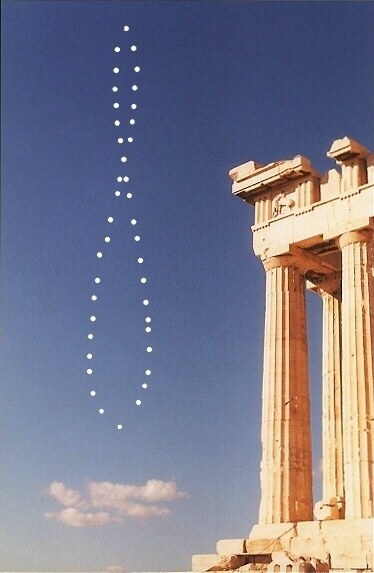tim-from-pa
Member
- Aug 4, 2005
- 4,716
- 436
:biglol Yes, it is losing time, but not because the thing's not set up right, but because right now the day is over 24 hours long. This is quite normal. It will be 24 hours again later this month, and then it will perhaps 20 seconds faster than 24 hours mid-September, and this variation of the day going several seconds slow, then fast will average out over any given year. This average length of the day is what we call "mean solar time".
So, to set up a sundial, it is not technically correct to say the sun is "due South" at noon. If we did have a nice, even motion of the sun in the heavens, and if we set up a camera to take a picture of the sun at noon daily for a year, we would expect to see a vertical line of suns in the south. The upward and downward motion of the sun being due to the tilt of the earth, the sun being high south in the summer, and low south in the winter. But that is not what we actually get if we were to snap a picture. Because a day is not exactly 24 hours but changes from day-to-day, this makes the sun speed up and slow down at various times, and we'd actually get a southern picture with the sun also moving left and right of the southern meridian like this:
View attachment 2519
This "figure 8" pattern is called an analemma as we gnomonists (sundial guys) would say, and the time difference between the sun and clock is called the equation of time. You add or subtract those minutes to sundial time to get your local (not time-zone) mean time. So the sundial is not really wrong, as a sundial is nothing more than a meridian marker but since the sun does not move at a constant rate, the sundial tells apparent solar time. Before the days of precise clocks, this was good enough given that the human mind cannot detect the slight variation in the length of the day. The sundial was the main time-keeping device. But with the advent of clocks, it was discovered that they did not agree, and at first people thought their clocks were wrong and had to be corrected!
And that's a mini-lesson on the length of the solar day, clocks and sundials. I'm fascinated with time.
So, to set up a sundial, it is not technically correct to say the sun is "due South" at noon. If we did have a nice, even motion of the sun in the heavens, and if we set up a camera to take a picture of the sun at noon daily for a year, we would expect to see a vertical line of suns in the south. The upward and downward motion of the sun being due to the tilt of the earth, the sun being high south in the summer, and low south in the winter. But that is not what we actually get if we were to snap a picture. Because a day is not exactly 24 hours but changes from day-to-day, this makes the sun speed up and slow down at various times, and we'd actually get a southern picture with the sun also moving left and right of the southern meridian like this:
View attachment 2519
This "figure 8" pattern is called an analemma as we gnomonists (sundial guys) would say, and the time difference between the sun and clock is called the equation of time. You add or subtract those minutes to sundial time to get your local (not time-zone) mean time. So the sundial is not really wrong, as a sundial is nothing more than a meridian marker but since the sun does not move at a constant rate, the sundial tells apparent solar time. Before the days of precise clocks, this was good enough given that the human mind cannot detect the slight variation in the length of the day. The sundial was the main time-keeping device. But with the advent of clocks, it was discovered that they did not agree, and at first people thought their clocks were wrong and had to be corrected!

And that's a mini-lesson on the length of the solar day, clocks and sundials. I'm fascinated with time.




 :
:
